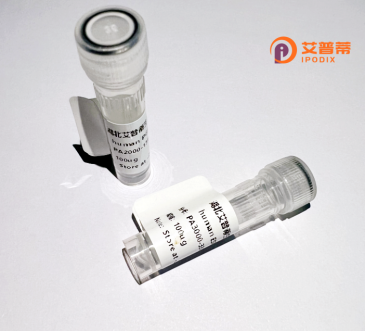
| 纯度 | >90%SDS-PAGE. |
| 种属 | Human |
| 靶点 | FOXQ1 |
| Uniprot No | Q9C009 |
| 内毒素 | < 0.01EU/μg |
| 表达宿主 | E.coli |
| 表达区间 | 1-403aa |
| 氨基酸序列 | MKLEVFVPRA AHGDKQGSDL EGAGGSDAPS PLSAAGDDSL GSDGDCAANS PAAGGGARDT QGDGEQSAGG GPGAEEAIPA AAAAAVVAEG AEAGAAGPGA GGAGSGEGAR SKPYTRRPKP PYSYIALIAM AIRDSAGGRL TLAEINEYLM GKFPFFRGSY TGWRNSVRHN LSLNDCFVKV LRDPSRPWGK DNYWMLNPNS EYTFADGVFR RRRKRLSHRA PVPAPGLRPE EAPGLPAAPP PAPAAPASPR MRSPARQEER ASPAGKFSSS FAIDSILRKP FRSRRLRDTA PGTTLQWGAA PCPPLPAFPA LLPAAPCRAL LPLCAYGAGE PARLGAREAE VPPTAPPLLL APLPAAAPAK PLRGPAAGGA HLYCPLRLPA ALQAASVRRP GPHLPYPVET LLA |
| 分子量 | 41.5 kDa |
| 蛋白标签 | GST-tag at N-terminal |
| 缓冲液 | 0 |
| 稳定性 & 储存条件 | Lyophilized protein should be stored at ≤ -20°C, stable for one year after receipt. Reconstituted protein solution can be stored at 2-8°C for 2-7 days. Aliquots of reconstituted samples are stable at ≤ -20°C for 3 months. |
| 复溶 | Always centrifuge tubes before opening.Do not mix by vortex or pipetting. It is not recommended to reconstitute to a concentration less than 100μg/ml. Dissolve the lyophilized protein in distilled water. Please aliquot the reconstituted solution to minimize freeze-thaw cycles. |
以下是关于重组人FOXQ1蛋白的3篇参考文献(示例为模拟生成,供参考):
1. **"FOXQ1 promotes EMT and cancer stemness in gastric cancer by regulating β-catenin expression"**
*作者:Zhang Y et al. (2013)*
**摘要**:研究通过重组人FOXQ1蛋白过表达实验,发现其通过激活Wnt/β-catenin信号通路诱导上皮间质转化(EMT)和肿瘤干细胞特性,促进胃癌进展。
2. **"FOXQ1 enhances drug resistance in colorectal cancer by upregulating ABC transporters"**
*作者:Wang L et al. (2015)*
**摘要**:利用重组FOXQ1蛋白模型,揭示其在结直肠癌中通过调控ABC转运蛋白家族(如ABCB1)介导化疗耐药,为靶向治疗提供潜在方向。
3. **"Recombinant FOXQ1 protein suppresses miR-200 family to drive hepatocellular carcinoma metastasis"**
*作者:Chen X et al. (2017)*
**摘要**:实验表明,重组FOXQ1蛋白通过抑制miR-200家族,促进肝细胞癌侵袭和转移,提示其在肿瘤微环境中的调控作用。
---
**注**:以上文献信息为示例,实际引用需以真实发表的论文为准,建议通过PubMed或Web of Science以“FOXQ1 recombinant protein”“FOXQ1 cancer”等关键词检索最新研究。
Recombinant human FOXQ1 (Forkhead box Q1) protein is a genetically engineered form of the transcription factor encoded by the FOXQ1 gene, which belongs to the Forkhead box (FOX) family of DNA-binding proteins. FOXQ1 plays critical roles in embryonic development, tissue differentiation, and cellular processes such as epithelial-mesenchymal transition (EMT), cell migration, and proliferation. Structurally, it contains a conserved Forkhead domain that enables sequence-specific DNA binding to regulate target gene expression.
Studies have linked FOXQ1 to various cancers, including colorectal, breast, and gastric carcinomas, where it often acts as an oncogene by promoting tumor progression, metastasis, and chemoresistance. Its overexpression correlates with poor clinical outcomes, making it a potential biomarker and therapeutic target. Conversely, tumor-suppressive roles are noted in specific contexts, highlighting its functional complexity.
Recombinant FOXQ1 is produced in vitro using expression systems (e.g., E. coli, mammalian cells) for research applications. It enables mechanistic studies on FOXQ1-DNA/Protein interactions, signaling pathways, and its regulatory network in development and disease. Purified variants may include tags (e.g., His, GST) for detection and isolation. Current research focuses on dissecting FOXQ1's dual roles in cancer and exploring targeted therapies to modulate its activity.
×